In this post we’ll look the supplements Andy Galpin uses with his athletes to help them achieve optimal performance.
Andy Galpin Supplements List
For Muscle Recovery:
- Creatine Monohydrate – dosed based on body-weight
- Glutamine – 20 grams a day (split into 2 doses)
- Curcumin – 500 mg curcumin – 3x day
- Omega-3 Fish Oil – 2 – 5 grams / day
Endurance:
- Nitric Oxide Boosters – increase blood flow of oxygen and nutrients
- Beet Extract – 5 to 8 mmol of nitrates – 90 mins prior
- Citrulline – 6 to 8 grams – 60 minutes prior
- Caffeine – stimulant – dose depends on individual
Further Supplements:
- Rhodiola Rosea – used for stress response modulation
- Ashwagandha – used for stress modulation and sleep

Muscle Recovery Supplements
There are three major post-exercise recovery supplements that Dr. Galpin recommends – these are supplements that he uses himself or with athletes he coaches.
Creatine
The first of these is Creatine – which is often one of the foundational supplements that many weightlifters swear by.
Whilst people tend to think of creatine in the context of muscle growth, it primarily helps this by enabling faster post-exercise recovery and reducing muscle soreness (source).

Dr. Galpin shared on Twitter a diagram (source) of further benefits of creatine:

Creatine Type: Dr. Galpin uses Creatine Monohydrate, as he says it’s the most well studied, and is also very cost effective.
Creatine Dosage: Dr. Galpin says the standard answer for “how much creatine to take per day” is 5 grams. However, in practice, he scales the dosage for his athletes based on their size (source).
He gives an example of a 125 lb female getting closer to 3 grams per day, but a 275 or 330 lb footballer, going up to between 7 and 10 grams per day.
Powder vs capsules: whilst capsules are generally preferential for supplements, given the quantity of creatine needed (~5 grams per day), powder form may be easier and cheaper.
Brand: Dr. Galpin has previously recommended Thorne’s Creatine (source) – but suggests that nearly everyone’s is the same.
Reputable brands of creatine monohydrate include:
| Product | Quantity | Price | Cost per 5g |
| Powders | |||
| Momentous – Creatine | 450 grams | $31 with coupon | $0.34 |
| Thorne – Creatine | 450 grams | $40 | $0.44 |
| Double Wood – Creatine | 500 grams | $24 with coupon | $0.24 |
| Capsules | |||
| NOW – Creatine | 120 x 750 mg | $11 | $0.63 |
| Life Extension – Creatine | 120 * 500 mg | $13 | $1.05 |

Glutamine
Galpin recommends glutamine for muscle recovery, saying that it helps helps with a specific phase he termed “proliferation”.
The proliferation phase of muscle repair is where “satellite cells” (a type of stem cells found on the outside of muscle) become activated, start to multiply (proliferate), then morph (differentiate) into muscle cells that help with the repair.
As the stem cells are multiplying, they need to replicate their DNA, and glutamine provides the nitrogen atoms needed to build the nucleotide bases (adenine, guanine, cytosine, thymine, and uracil) that are part of the DNA.
Glutamine is an amino acid your body can produce but Galpin suggests supplementation is helpful for athletes undergoing intense training.
He also says that there’s little downside to taking Glutamine because your body can convert it into multiple things, based on what it needs at the time.
Dose: Dr. Galpin recommends taking 10g in the morning and 10g in the evening.
Powder vs capsules: whilst capsules are generally preferential for supplements, given the quantity of glutamine needed (up 20 grams per day), powder form makes more sense.
Sources of L-Glutamine include:
- Momentous – L-Glutamine – 300g powder
- NOW – L-Glutamine – 1 lb (454g) powder

Curcumin
Dr. Galpin is a big fan of curcumin for reducing muscle soreness.
This is due to curcumin being able to help modulate inflammation – however, he states in this podcast with Andrew Huberman that timing is important with supplements that influence inflammation.
He recommends avoiding taking Curcumin immediately after training – waiting a few hours at least for the initial effects of inflammation to wear off as they are an important and natural part of the body’s adaptation to exercise.
He recommends 500mg of curcumin 3 times a day and likes the Thornes Curcumin product Meriva (source).
Meriva is a patented form of curcumin that is bound to sunflower lecithin, in order to enhance the bio-availability.
Reputable brands of Meriva curcumin include:
- Momentous Meriva – 500 mg capsules
- Thorne Meriva – 500 mg capsules
- Now Meriva – 500 mg capsules
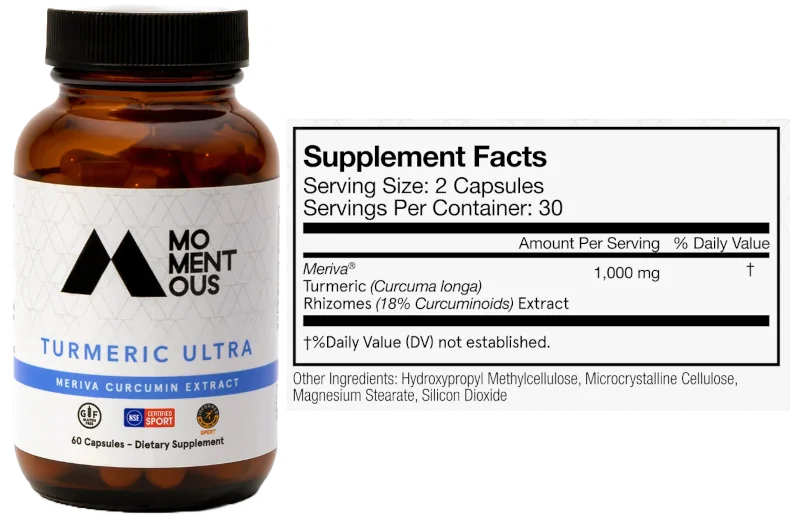
Omega-3 Fish Oil
Andy Galpin is a fan of using fish oil (omega-3) supplements regularly.
There is a host of literature on the benefits of supplementing with fatty acids from fish – positively affecting everything from mood to skeletal muscle recovery, and enhancing how the body handles inflammation.
Dose: He suggests taking between 2-5 grams of omega-3s (source).

Below are examples of reputable fish oil brands, along with the 3rd party testing data on total oxidation and heavy metals:
| Name | Price | Flavored? |
Quantity | EPA/DHA |
Total Oxidation* | Heavy Metals* |
IFOS Test |
| Viva Naturals Triple Strength | $22 with coupon | Unflavored | 90 soft gels | 773 / 269 mg | 7.39 | Passed |
Link |
| Carlson Maximum Omega 2000 | $29 with coupon | Lemon Flavor | 60 soft gels | 668 / 284 mg | 5.04 | Passed | Link |
| Thorne Super EPA | $33 with coupon | Unflavored | 90 soft gels | 425 / 270 mg | No data** |
No data** | N/A** |
| Momentous Omega-3 | $32 with coupon | Lemon Flavor | 60 soft gels | 375 / 375 mg | No data** |
No data** | N/A** |
*Oxidation levels & heavy metal results come via IFOS batch tests
**Thorne and Momentous do not participate in IFOS testing, hence no data
Vegan / Vegetarian Fish Oil Alternatives?
For those who don’t consume fish products, getting enough EPA and (particularly) DHA can be difficult.
Often vegetarians/vegans will rely upon consuming foods that contain alpha linolenic acid (ALA), but this has a few issues:
- ALA is weakly converted to EPA – Research estimates between 0.2% to 6% of ALA is converted to EPA1Metabolism of α-linolenic acid in humans – G.C. Burdge | (see section 7.2 of paper) | 2006 | Journal: PLEFA.
- ALA barely converts to DHA – The same research paper above estimates 0.05% or less of ALA is converted to DHA2Metabolism of α-linolenic acid in humans – G.C. Burdge | (see section 7.2 of paper) | 2006 | Journal: PLEFA.
- This aligns with research showing that vegetarians and vegans have lower levels of EPA & DHA compared to those who eat fish3Blood docosahexaenoic acid and eicosapentaenoic acid in vegans: Associations with age and gender and effects of an algal-derived omega-3 fatty acid supplement – Sarter et al. | 2014 | Clinical Nutrition.
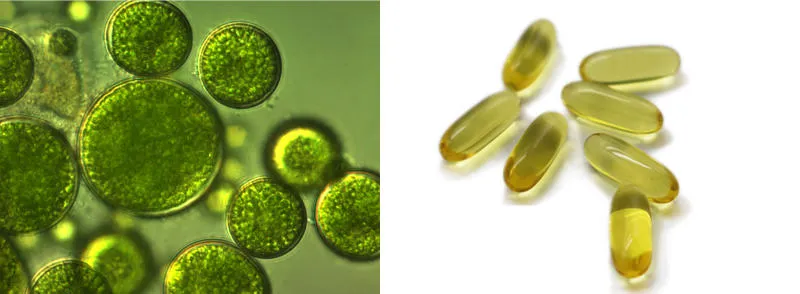
The good news is that research shows algae based omega-3s will raise EPA & DHA levels in vegans, even at relatively low dose4Blood docosahexaenoic acid and eicosapentaenoic acid in vegans: Associations with age and gender and effects of an algal-derived omega-3 fatty acid supplement – Sarter et al. | 2014 | Clinical Nutrition.
A study showed their omega-3 index score went from 3.1 to 4.8 after 4 months of taking 172mg DHA & 82mg of EPA per day.
Below are a couple of algae based omega-3s, so you can see their cost per gram of EPA & DHAs:
| Name | Price | Quantity | Flavored? | EPA/DHA $/gram |
| Source Naturals - Non-Fish Omega-3s | $15 with coupon | 30 soft gels | Sorbitol sweetener | $5.44 / $2.72 |
| Sun Warrior - Algae-Based Omega-3 | $20 with coupon | 60 soft gels | Maltitol sweetener | $5.89 / $1.33 |
| Deva - Vegan Omega-3 | $32 with coupon | 60 soft gels | Vegetable glycerin | $3.55 / $1.77 |
Supplements for Endurance
Nitric Oxide Boosters
Below we’re going to look at the nitric oxide boosters; beets and Citrulline.
They help in terms of exercise performance primarily by:
- Increasing blood flow to areas that need it. During exercise this means increased transport of oxygen and nutrition (glucose, lipids, etc) into areas such as skeletal muscle.
Whilst these compounds don’t provide exercise performance benefits in every study, there are a significant number of studies suggesting benefit5Acute l-arginine supplementation reduces the O2 cost of moderate-intensity exercise and enhances high-intensity exercise tolerance | Bailey et al. | 2010 | Journal of Applied Physiology6The Effect of Nitric-Oxide-Related Supplements on Human Performance – Besco et al. | 2012 | Sports Medicine7Effects of Arginine-Based Supplements on the Physical Working Capacity at the Fatigue Threshold | Clayton et al. | 2010 | Journal of Strength and Conditioning Research8Effects of Citrulline Supplementation on Exercise Performance in Humans: A Review of the Current Literature | Gonzalez et al. | 2020 | Journal of Strength and Conditioning Research.
I would imagine that the reliability of results depends on variables including:
- Age, health status & exercise specialization: The closer people are are to maximum conditioning and efficiency, the less room there is to squeeze out more performance.
- Dose and timing – these vary in the studies, and will have an impact.
- Type of exercise – presumably some will see benefit more than others.
Dr Galpin discusses, in his interview with Andrew Huberman, two nitric oxide boosters that he uses with athletes, specifically beets (the vegetable), and citrulline, an amino acid you can buy as a supplement.

^ Beets pathway (left), citrulline pathway (right) – image source
You can see from the above diagram the two different pathways that beets and citrulline utilize to increase nitric oxide.
Beets / Beet Root Extract

Consuming beets is one of the most well studied methods of increasing nitric oxide.
A 2017 meta-analysis9Effects of Beetroot Juice Supplementation on Cardiorespiratory Endurance in Athletes. A Systematic Review | Dominguez et al. | 2017 | Journal of Sport and Health Science (open access), which looked at 23 studies in the context of beet juice and exercise performance, concluded by saying (rephrased without excessive technical terms):
- Consuming beets prior to exercise may make your workout more effective. It could help reduce the amount of oxygen your body needs even when you’re working out intensely. This means you’re using your body’s energy more efficiently. Plus, it could allow you to keep going for longer before getting too tired when you’re exercising at high intensity.
Additionally, the study suggested that the timing of beet consumption is important, saying it should be consumed around 90 minutes prior to athletic effort, because the peak value of nitrate (a precursor to nitric oxide) occurs within 2–3 hours after ingestion.
If you consumed beets just before the workout, then due to the digestion time, you may not experience maximal benefits.
Dose: Whilst I haven’t seen Dr. Galpin talk explicitly on beet juice dosage, we can see from the aforementioned meta-analysis that most studies standardized at 5 to 8 mmol of nitrates per dose.
Timing: 90 minutes prior to exercise.
Unfortunately, as this study10What Is in Your Beet Juice? Nitrate and Nitrite Content of Beet Juice Products Marketed to Athletes | Gallardo et al. | 2019 | International Journal of Sport Nutrition and Exercise Metabolism points out, there’s a lot of variance in beet juice nitrate concentration, so it’s not possible to give a single figure for how much to consume. The image below (click to expand) neatly visualizes the paper’s findings on beet juice nitrate content:

^ Image source, based on this paper
Another approach is to use a supplement called citrulline, which we’ll discuss below, and can be dosed with more precision.
Citrulline
Citrulline is a non-essential amino acid that’s produced naturally in the human body.
Supplementing it can increase nitric oxide in the following way:
- After ingesting citrulline it travels to the kidneys where enzymes there convert it into another amino acid called arginine.
- Arginine acts as a substrate for an enzyme called nitric oxide synthase (NOS). NOS then converts arginine into nitric oxide.
You might have noticed in the above explanation that citrulline gets converted to arginine, another amino acid. The reason for not going “straight to the source” and supplementing arginine, is that studies have shown that arginine gets broken down during digestion11Pharmacokinetic and pharmacodynamic properties of oral L-citrulline and L-arginine: impact on nitric oxide metabolism | Schwedhelm et al. | 2008 | British Journal of Clinical Pharmacology.
This 2020 meta-review12Effects of Citrulline Supplementation on Exercise Performance in Humans: A Review of the Current Literature | Gonzalez et al. | 2020 | Journal of Strength and Conditioning Research (open-access) of citrulline supplementation for exercise performance gives a good overview of the research to date.

Image source
Dose: I haven’t seen Dr. Galpin share the doses of Citrulline he prefers. However, we can look to research papers to understand commonly tested doses.
It’s worth noting that there are 2 forms of Citrulline that are commonly used; the first is “pure” Citrulline (also called L-Citrulline). The second is Citrulline complexed with Malic Acid, called Citrulline Malate (CM).
The theory behind the addition of malate is that it is a key component of energy production (krebs cycle), and more malate may lead to increased energy production. I haven’t however seen a head to head comparison of Citrulline vs Citrulline Malate.
Dose for Citrulline – studies vary in the dose used. WebMD and Cleveland Clinic both suggest doses in the range of 3 – 6 grams per day.
Dose for Citrulline Malate – the most common dose used in studies is 8 grams, with a couple using 6 grams also. See table 1 of this study13A critical review of citrulline malate supplementation and exercise performance | Gough et al. | 2021 | European Journal of Applied Physiology for a list of doses used. 8 grams of CM, at the (common) 2:1 ratio, means there is 5.28g of pure L-Citrulline.
Timing: 1 hour prior to exercise.
Timing Rationale: for Citrulline to boost Nitric Oxide, which happens by way of increased arginine, you need to wait for it to be metabolized and converted into arginine. In this paper14Effect of citrulline on post-exercise rating of perceived exertion, muscle soreness, and blood lactate levels: A systematic review and meta-analysis| Rhim et al. | 2020 | Journal of Sport and Health Science arginine reached peak concentration between 1hr 17 mins and 2hr 29 mins after Citruline supplementation. With some natural variance between subjects.
Capsules vs Powder: Given the size of dose needed, using powder may be easier than taking a lot of capsules.
Reputable brands of “pure” Citrulline:
Powders
- NOW Foods – L-Citrulline – 4 oz (113 g)
- Doctor’s Best – L-Citrulline – 7 oz (200 g)
Capsules
- Double Wood – L-Citrulline – 1,200 mg per capsule – use 15% off coupon
- NOW – L-Citrulline – 1,200 mg per capsule

Brands of Citrulline Malate include:
Powders
- ALLMAX – Citrulline Malate 2:1 – 10.58 oz (300 g)
- Primaforce – Citrulline Malate 2:1 – 7 oz (200 g)
Caffeine

These days I think everyone is familiar with caffeine, whether it’s tea, coffee, sodas or energy drinks – it’s available (and consumed!) in abundance.
In the context of sports performance, Dr. Huberman states it can aid in:
- Reaction Speed
- Power Output
- Endurance
With Dr. Galpin emphasizing that endurance is where he sees the greatest benefits.
One thing to note is that Dr. Galpin and Dr. Huberman agree that using excessive amounts of caffeine can really degrade performance, because the individual does not know how to operate at that high level of autonomic arousal. What constitutes “excessive amounts” will depend upon the individuals tolerance.
Dose: Dr. Huberman suggests a rough guide is 1-3 mg per kg of body weight.
With Galpin pointing out that everyone has to find the dose that works for them, and that will vary depending on tolerance. 1mg per kg may be plenty for someone with a low tolerance, whereas a regular user may need more.
Timing: Whilst Dr. Galpin didn’t discuss timing specifics, this paper15Are the Current Guidelines on Caffeine Use in Sport Optimal for Everyone? Inter-individual Variation in Caffeine Ergogenicity, and a Move Towards Personalised Sports Nutrition | Pickering et al. | 2018 | Sports Medicine suggests caffeine can hit the bloodstream as early as 15 minutes post-ingestion, with peak concentration at around 1 hour.
Further Supplements
Rhodiola Rosea
Dr. Galpin says he has used Rhodiola with his athletes for around 6 years (see 1hr 52m).
In particular to modulate cortisol levels, and keep them within a healthy range.
^ Clip source
The researched benefits of Rhodiola include:
- Reducing physical fatigue & enhancing memory and cognition under stress16Rhodiola rosea in stress induced fatigue–a double blind cross-over study of a standardized extract SHR-5 with a repeated low-dose regimen on the mental performance of healthy physicians during night duty | Darbinyan et al. | 2000 | Phytomedicine17A double-blind, placebo-controlled pilot study of the stimulating and adaptogenic effect of Rhodiola rosea SHR-5 extract on the fatigue of students caused by stress during an examination period with a repeated low-dose regimen | Spasov et al. | 2000 | Phytomedicine18A randomized trial of two different doses of a SHR-5 Rhodiola rosea extract versus placebo and control of capacity for mental work | Shevtsov et al. | 2003 | Phytomedicine
Dr. Galpin has also co-authored a literature review of Rhodiola – link.
It’s worth noting that all those studies appear to have been run by the Swedish Herbal Institute (SHI) using their standardized Rhodiola extract called SHR-5.
The Swedish Herbal institute is a company that researches and produces standardized formulations of adaptogenic herbs.
They have a version of Rhodiola they call SHR-5, for which they’ve run 7 clinical studies on, all listed on their site.
From details of the methods section in this study, it appears that SHR-5 appears to be:
- 390 mg tablets, each containing 144 mg of Rhodiola root extract
- Extracted at a ratio of 4:1 using a 70% ethanol extraction
- With 4 mg per tablet of salidroside (also known as rhodioloside), so ~2.7% concentration. Salidroside is considered to be one of the main active ingredients along with rosavin, tyrosol and triandrin.
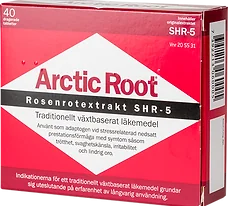
It’s of course worth pointing out their conflict of interest with the studies they have run – given they have a financial interest in showing efficacy. That said, with non-patented natural herbs, there will always be an issue around funding for proper studies.
If someone is looking to closely replicate the results from their studies, then it may be worth getting hold of this specific SHR-5 extract. However, it’s not widely available.
The two example brands I’ve listed below have 2 mg and 15 mg salidrosides per capsule, respectively (Momentous & Double Wood).
In terms of doses used in each study, the table below lists them:
| Study Name | Dose |
| A Randomised, Double-Blind, Placebo-Controlled, Parallel-Group Study of the Standardised Extract SHR-5 of the Roots of Rhodiola rosea in the Treatment of Subjects with Stress-Related Fatigue – link | 576 mg per day – split 50/50 morning and lunch – for 28 days |
| A randomized trial of two different doses of a SHR-5 Rhodiola rosea extract versus placebo and control of capacity for mental work – link | 2 dose groups – 370 or 555 mg each – 1 dose |
| A double-blind, placebo-controlled pilot study of the stimulating and adaptogenic effect of Rhodiola rosea SHR-5 extract on the fatigue of students caused by stress during an examination period with a repeated low-dose regimen – link | 50 mg twice daily – for 20 days |
| Rhodiola rosea in stress induced fatigue — A double blind cross-over study of a standardized extract SHR-5 with a repeated low-dose regimen on the mental performance of healthy physicians during night duty – link | 170 mg daily for 14 days |
Example brands of Rhodiola include:
- Momentous – Rhodiola Rosea – 100 mg per capsule (see 15% off discount code)
- Double Wood – Rhodiola Rosea – 500 mg per capsule (see 15% off discount code)
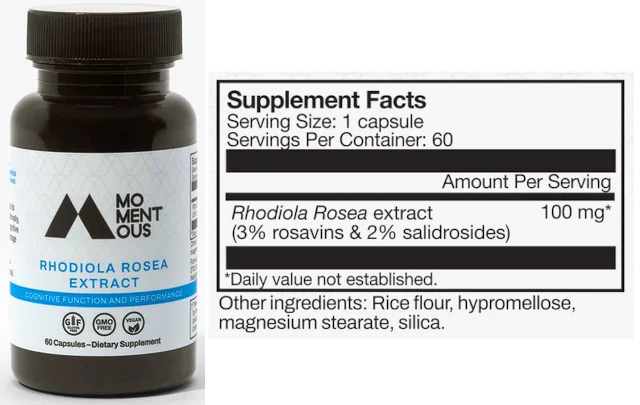
Ashwagandha
Galpin discusses Ashwagandha in his 2024 interview with Tim Ferriss, saying that it’s primarily useful for:
- Regulating cortisol, which can aid in stress management and sleep
Then, more anecdotally, he says that cortisol has an antagonistic relationship with testosterone. Meaning that lowering cortisol could raise testosterone, and vice-versa.
He says that with his athletes he has to source NSF certified products to avoid risk of contamination from banned substances. In this case, the only brand he’s aware of that does Ashwagandha are Klean Athlete.
For non-drug tested athletes, other reputable sources include:
- Jarrow – Ashwagandha (KSM-66) – 300 mg per capsule (see 20% off coupon code)
- Life Extension – Ashwagandha (Sensoril) – 125 mg per capsule (see 20% off coupon code)
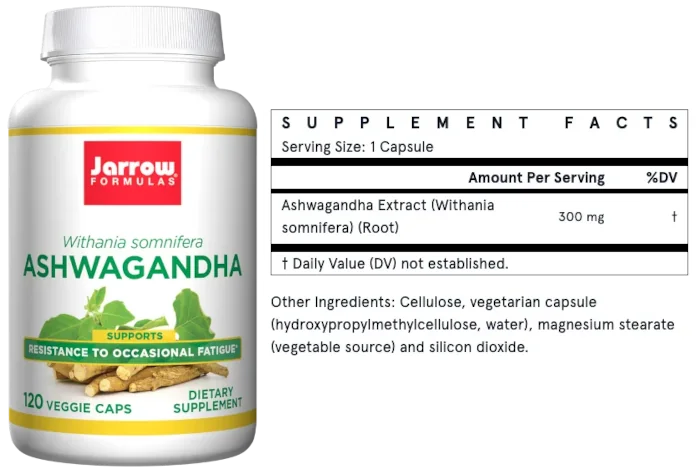
Some Final Notes From Dr. Galpin on Supplements
There are some other factors that Dr. Galpin believes are crucial when discussing supplementation and what substances you are putting in your body.
- He is a fan of many supplements, but he firmly states that they are tools to help physiology and not there to be used as crutches to be dependent on.
- Using single-ingredient formulations allow you to understand whether or not a specific supplement is having a positive effect on you or not. Compared to supplements that contain multiple ingredients, making it hard to know which of them is having an effect.
- Supplement ingredients should be verified by a 3rd party to ensure that you’re getting what the container says you’re getting.
- As an example, he states that it’s very common in Melatonin supplements for there to be vastly more of it than listed in the ingredients, which totally alters how your body responds and can lead to negative health outcomes.
- Most supplements and online supplement stores will explicitly say if they have third-party verification.
- Athletes, if they are subject to drug testing in their sport, should use a supplement brand that are certified for sport. An example are Momentous, whose supplements are NSF certified for sport.

^ Dr. Galpin with Bellator MMA champion Ryan Bader (source). He has worked with a number of MMA fighters, including Brian Ortega and Lauren Murphy
Further Reading
If you enjoyed this post, you may also be interested in:
- The Galpin Equation – how to calculate it and why it’s important for sports hydration
- The Galpin Equation Calculator – to save doing the calculations by hand
- Andrew Huberman Supplements – List of What He Takes & Why
References
- 1Metabolism of α-linolenic acid in humans – G.C. Burdge | (see section 7.2 of paper) | 2006 | Journal: PLEFA
- 2Metabolism of α-linolenic acid in humans – G.C. Burdge | (see section 7.2 of paper) | 2006 | Journal: PLEFA
- 3Blood docosahexaenoic acid and eicosapentaenoic acid in vegans: Associations with age and gender and effects of an algal-derived omega-3 fatty acid supplement – Sarter et al. | 2014 | Clinical Nutrition
- 4Blood docosahexaenoic acid and eicosapentaenoic acid in vegans: Associations with age and gender and effects of an algal-derived omega-3 fatty acid supplement – Sarter et al. | 2014 | Clinical Nutrition
- 5Acute l-arginine supplementation reduces the O2 cost of moderate-intensity exercise and enhances high-intensity exercise tolerance | Bailey et al. | 2010 | Journal of Applied Physiology
- 6The Effect of Nitric-Oxide-Related Supplements on Human Performance – Besco et al. | 2012 | Sports Medicine
- 7Effects of Arginine-Based Supplements on the Physical Working Capacity at the Fatigue Threshold | Clayton et al. | 2010 | Journal of Strength and Conditioning Research
- 8Effects of Citrulline Supplementation on Exercise Performance in Humans: A Review of the Current Literature | Gonzalez et al. | 2020 | Journal of Strength and Conditioning Research
- 9Effects of Beetroot Juice Supplementation on Cardiorespiratory Endurance in Athletes. A Systematic Review | Dominguez et al. | 2017 | Journal of Sport and Health Science
- 10What Is in Your Beet Juice? Nitrate and Nitrite Content of Beet Juice Products Marketed to Athletes | Gallardo et al. | 2019 | International Journal of Sport Nutrition and Exercise Metabolism
- 11Pharmacokinetic and pharmacodynamic properties of oral L-citrulline and L-arginine: impact on nitric oxide metabolism | Schwedhelm et al. | 2008 | British Journal of Clinical Pharmacology
- 12Effects of Citrulline Supplementation on Exercise Performance in Humans: A Review of the Current Literature | Gonzalez et al. | 2020 | Journal of Strength and Conditioning Research
- 13A critical review of citrulline malate supplementation and exercise performance | Gough et al. | 2021 | European Journal of Applied Physiology
- 14Effect of citrulline on post-exercise rating of perceived exertion, muscle soreness, and blood lactate levels: A systematic review and meta-analysis| Rhim et al. | 2020 | Journal of Sport and Health Science
- 15Are the Current Guidelines on Caffeine Use in Sport Optimal for Everyone? Inter-individual Variation in Caffeine Ergogenicity, and a Move Towards Personalised Sports Nutrition | Pickering et al. | 2018 | Sports Medicine
- 16
- 17
- 18A randomized trial of two different doses of a SHR-5 Rhodiola rosea extract versus placebo and control of capacity for mental work | Shevtsov et al. | 2003 | Phytomedicine


